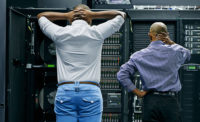5 Common Types of Unauthorized Access and How to Combat Them

Before you evaluate or purchase an access control system, it is critical to have a good understanding of what you need such a system to do. For starters, you have to be clear about what “unauthorized access” means and how it may happen within your organization. There are a number of ways a building can be accessed by an unauthorized individual, which may occur on a daily basis at a particular location.
From doors that are left open when they should be closed to easily forged credentials, there are a number of types of unauthorized access that can leave an organization at risk. In some cases, the very technologies that have been deployed to control access can introduce risk. All possibilities need to be considered when thinking about an access system, because once you have an idea of how unauthorized access can occur at your business, you’ll have an easier time determining whether the access control solution you’re considering will meet your actual needs.
Here are five of the most common ways unauthorized access can occur, along with some methods and technologies for combatting them.
Tailgating
One of the most common types of unauthorized access is tailgating, which occurs when one or more people follow an authorized user through a door. Often the user will hold the door for an unauthorized individual out of common courtesy, unwittingly exposing the building to risk. One way to decrease the likelihood of tailgating is by giving training to all credentialed users on security and awareness. An even more effective reduction technique is to implement turnstiles, mantraps or another solution that restricts entry to one individual at a time and generates an alarm if someone tries to circumvent it.
Door Propping
Similar to tailgating, propping doors open, most often for convenience, is another common way unauthorized individuals gain access to a location and potentially create a dangerous situation for the people and assets within. Some access control systems include the capability to detect when doors are propped and alert security personnel, who can respond and investigate the situation as needed.
Levering Doors
You might be surprised to know how easily many doors can be levered open using something as small as a screwdriver or as large as a crowbar. Advanced access control systems include forced-door monitoring and will generate alarms if a door is forced. The effectiveness of these systems varies, with many systems prone to a high rate of false positives, poor database configuration or lack of active intrusion monitoring. With these tools and tactics in place, however, they are highly effective at detecting door levering.
Keys
Whether stolen, lost or loaned out, keys pose a major problem. They are often impossible to track when lost, forgotten, stolen or loaned to someone else, and if an individual tends to tailgate to enter the building, he or she may not notice missing keys for several days. During that time, there is huge risk, and the only way to ensure the continued security of a building is to re-core locks on multiple doors, which can be very expensive. Electronic key management solutions can be deployed to track keys, with the added benefit that many of these systems can be integrated with access control for an added layer of security.
Access Cards
With the added advantage of identifying authorized users who swipe in with an access control reader, electronic key cards are a more high-tech alternative to traditional keys. However, they are prone to the same risks associated with keys, namely the potential to be lost, stolen or shared with an authorized or unauthorized person.
From a technology perspective, there are four main categories of access cards: Magnetic stripe, proximity, proximity smart cards and contact smart cards. Each has its pros and cons, with some more susceptible to risk than the others. Magnetic stripe cards are the easiest to duplicate and are susceptible to wear and tear or damage from magnetic fields. Proximity cards and smart cards are much less susceptible to duplication, and smart proximity cards can be programmed with much more information than access cards, allowing them to be used for a variety of interactive applications in addition to physical access, including network access. Some proximity smart cards, however, require a small battery, which can diminish their lifespan.
The effectiveness of access control cards can be improved if they also serve as photo identification cards, which decreases the likelihood that individuals will forget them at home. Complementary technologies and solutions, such as individual identification cards and/or biometrics, bring even greater reliability and effectiveness to access cards.
Unauthorized access can create dangerous situations for any business or organization, so it’s important to choose access control technologies that will combat this risk. To make the most informed choice, it’s vital to not only consider but to understand these five most widespread types of unauthorized access. If your organization is susceptible to any or all of these risks, it’s important to seek an access solution that will address those specific risks to reduce or even eliminate the possibility of unauthorized access and ensure the highest level of security for your facility.
Looking for a reprint of this article?
From high-res PDFs to custom plaques, order your copy today!





